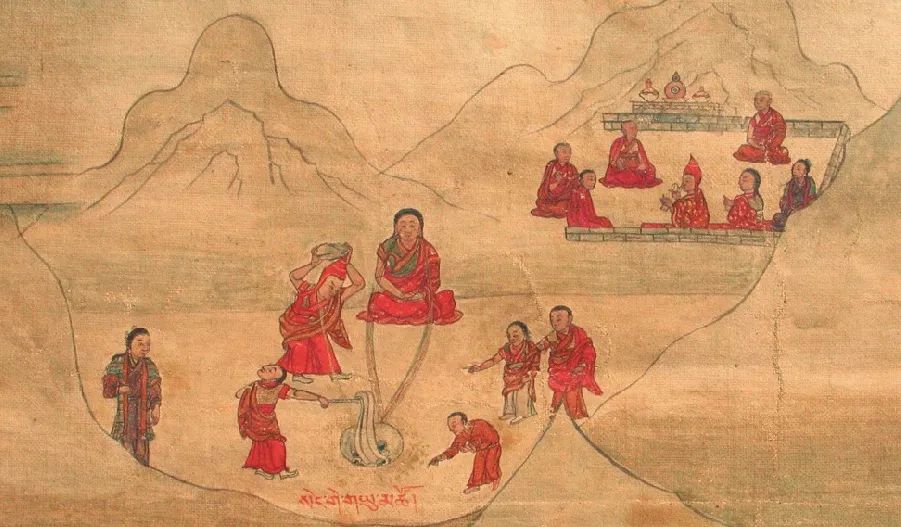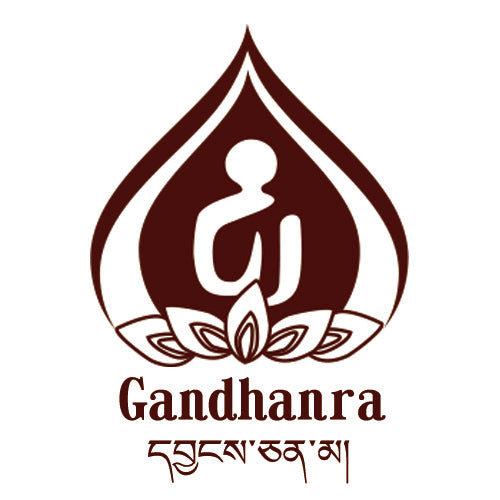
Carving wisdom on the cliff and hiding it under the lake surface | Key Moments about the Himalayas (8)

"Diagram of Two Bodhisattvas at the White Tiger Cave and Lion Jade Lake" Facade
Late 19th century (1866-1870), Derge Monastery

"Two Champions at the White Tiger Cave and Lion Jade Lake Treasure Map"
Detail: Master and disciple together uncover the hidden treasure map.
(…)At midnight, the sound of music and dancing echoed continuously
The beautiful chanting also lingered in the ears
The excitement for the emergence of the treasure was unstoppable
I, along with my fellow disciples and the officials of Degue Wang
Went to the meditation cave as the earth trembled
We held a ceremony with the sound of chanting and prayers buzzing endlessly(…)
Extract from "1866 Hidden Treasures Inventory and Remarks"
(Authored and handwritten by the Master of Hidden Treasures, Juulingpa, along with his disciple)
* The following excerpt is recorded on the ninth day of the tenth month in the Tibetan calendar (November 16th).

Late 19th Century (1866-1870), Derge Monastery
It is generally believed to have been written by the owner of the hidden treasures.

"The Two Lords excavating treasures in the White Tiger Cave and Lion Jade Lake"
Detail: "The Two Lords excavating treasures in the Lion Jade Lake"
When the news of the suicide of Zhandui Gongbulangjie (1799-1865) spread throughout the eastern Tibetan areas (some say he was burned to death by Tibetan troops), the long-oppressed leaders and people of the Khampa region finally breathed a sigh of relief. As a utilitarian believer and a model of Khampa-style strongman, Zhandui Gongbulangjie had treated the Khampa region as a testing ground for his political ideas for over a decade, and his expanding political ambitions eventually earned the enmity of the Qing government and the Lhasa authorities.
From "born with extraordinary strength and cunning intelligence, many children are under his command" (Qing dynasty official Zhang Ji), to "forests and grasslands are often destroyed, countless people and monks are killed" (oral history of Dege region), the evaluation of Gongbo Lajia by modern historians basically fluctuates between "great resistor" and "cruel ruler". There is no doubt that Zhanjog Gongbo Lajia's political influence is profound, as he continues to become a private idol for local leaders, undermining the previously stable political system and the authority of local kings, including that of Dege.
When Gonpo Namgyal began his attack on Derge in late 1862, the Derge king, Chimey Dado Jigme Dode, also known as Chime Daga Pema Dudul (འཆི་མེད་རྟག་པའི་རྡོ་རྗེ་; 1840/1841-1896/1898), was only 22 years old and had been in full control since 1853. There are not many descriptions of Chime Dado Jigme Dode's early life: the high monks and bureaucrats of the kingdom believed him to be a promising talent and bestowed upon him the titles of "prodigy and devout believer"; however, a small group of local leaders considered the new king to have a twisted character and lack royal demeanor, believing him more suited to be a practitioner.
Following the capture of Degé by the Gonpo Tseten government in 1863, the new king and his family were taken to Xiangduo (mainly within the boundaries of Xindu county). However, the newly acclaimed king seemed somewhat reluctant to stay in Xiangduo. It was only after the fall of the Gonpo Tseten regime in 1865 that the new king and his family returned to their homeland. In order to restore the authority that had been gradually lost during the war, the queen mother (along with some courtiers) began to oversee a series of "cultural-religious" activities favorable to the reestablishment of royal power, the most notable of which was the excavation ceremony and related celebrations in 1866.

"Jamyang Tashi Wangpo"
Late 19th century, private collection
From "Silence and Wrath: Cultural and Artistic Aspects of Tibetan Buddhism"

"The Hidden Master and the Longchen Nyingthig Lineage Masters"
From the Robben Museum collection in the mid-19th century.

"Ruins of the Fortress of Gongbu Langjie"
In the mid-19th century, located in the territory of Le'an Township in Xindragon County
(as identified by local residents)
An article by Jiang Yangguang, known as "The Sun of the Tibetan Plateau"
The grand celebration, involving dignitaries from all walks of life (royal family, important local leaders, exemplary commoners from three generations, and leaders of significant monasteries), began on November 2, 1866, and concluded on November 19. This eighteen-day kingdom event was widely documented in the biographies of eminent monks in the Kang region, with particular emphasis on the recounting of the "Three Manjushri Incarnations." These revered "Three Manjushri Incarnations" were the three revered masters who collaborated during the later period of the Gongkar Jampa Ling lineage, and were the founders of the well-known "Lime Movement": Sangye Chinzhi Wangpo (1820-1892), Jang Gongkangzhu (1813-1899), and Qie Julinba (1829-1870).
On the back of this painting depicting the discovery of hidden treasures by Tsogyal Wangpo and Jigme Lingpa in a mountain lake, the entire process of the celebration is written. For Jigme Lingpa, the youngest of the three incarnations, and with the strongest sense of self, this recognition of their discovery by the local authorities and high lamas was crucial. In the 19th century, different philosophical traditions in Tibet had varying attitudes towards hidden treasures. Many still considered them as dubious and often fabricated claims. Therefore, an event such as this, where representatives from different sectors of society documented the discovery, was truly a celebration for the treasure revealers (subsequently, the lineage holders of Jigme Lingpa's teachings placed great importance on narratives of this event).
The young tulku Dorje Drakpa left Nangchen for Dege at the age of twenty-five, facing disdain from the monks and doubts about his tulku status as reasons for his departure. He did not forsake all opportunities to prove his identity, as Dege offered a promising ground for his aspirations. Despite the relatively tolerant religious atmosphere in Dege, Dorje Drakpa did not immediately receive recognition. Situ Rinpoche, who held significant political and religious power, did not acknowledge his tulku status or previous incarnations, and the cautious Janggon Konchok Gyaltsen did not immediately affirm Dorje Drakpa either.
It was not until 1855 that Jenang Qinzewangbo began to consider Jigme Lingpa as a wise man who could be his teacher, and Jang Gongqiang Zhu also started to seriously consider the authenticity of Jigme Lingpa as the "foremost hidden treasure revealer of the time" (Jigme Lingpa had cured Jang Gongqiang Zhu's eye ailment). By 1857, Jigme Lingpa's prestige in the Dege region had grown significantly, and scholars within the kingdom began to take notice of the various miracles attributed to him. When the royal family returned, the hidden treasure revealer also returned from Nangchen to Dege, signaling the huge success of the hidden treasure ceremony the following year. The royal family even needed Jigme Lingpa to authenticate the new king's coronation ceremony.

"Explanation of Sacred Sites in the Text"
Author made
Purple: Degong Zongsa Temple
Black: Holy Lion Jade Lake
Yellow: Rongmai White Tiger Cave
Red: Holy Pema Shelpuk
(Incarnation of Jang Yangqinzi Wangbo; since 1857)

"Diagrams of the Two Supreme Emperors' Excavation in the White Tiger Cave and Lion Jade Lake"
Details: Welcoming and Hiding - Making Ladders - Royal Officials and People Offering Tribute
The figure wearing red clothes in the bottom right corner is often believed to be the King of Dege.

"Second Supreme at White Tiger Cave and Lion Jade Lake Digging Map"
Detail: Rituals before the excavation
Above center: Jiang Yangqin Zaiwangbo
Center right: Que Jiulinba's son Ciwang Zhaba
(约1854-1881)
Bottom left: Que Jiulinba's spouse Deji Quzhen
(1832-1887)
Bottom right: Que Jiulinba
Since there were doubts about the authenticity of the hidden treasures and the revelations of the terma texts, the royal family played a crucial role as the observers (irreplaceable supporters) of the entire treasure-revealing ceremony. In the records written by the terton and revealer of the hidden treasures, the treasures were acknowledged due to being seen by many and constantly manifesting themselves (especially with the help of Sangye Chentse Wangpo). Throughout the process of Sangye Chentse Wangpo and the terton discovering the treasures, the masters continued to emphasize to the people the importance of royal authority in the transmission of the teachings: how the king bases his rule on both secular and Buddhist principles, and how ministers and local leaders obey the king's commands, showing that worldly life is the best arena for the practice and propagation of the Dharma.
Until the death of Kyabge Lama, who received the highest honor and many successors in Kham region, the latter part of the life of the old king, known as Wangshang Lama (Rig Ngam Ma; also known as Chimed Dawa Dondrub), did not go as smoothly as his blessings. Power struggles in his harem were too intense, and there were many rebellious local leaders, causing the whole kingdom to decline. In 1896, the king and queen, two princes who would later influence Kham politics, and some court officials were abducted by Qing officials to Chengdu, where the king eventually died in a foreign land (some say he died on the way to Derge).

"Map showing the locations of treasures hidden in the White Tiger Cave and Lion Jade Lake"
Details: Map showing the locations of treasures hidden in different caves

